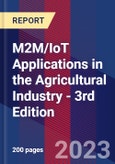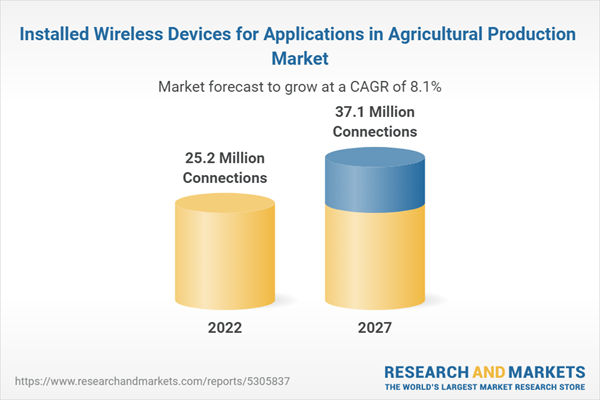IoT Applications in the Agricultural Industry is the third consecutive strategy report analysing the latest developments on the global smart farming market covering precision farming, agricultural drones, in-field monitoring, herd management and farm management software. This strategic research report provides you with 200 pages of unique business intelligence, including 5-year industry forecasts and expert commentary on which to base your business decisions.
How will the market for agricultural IoT applications evolve in 2024 and beyond? The report covers the latest trends and developments in the emerging smart farming market. The report forecasts that the number of installed wireless devices for applications in agricultural production is forecasted to grow at a CAGR of 8.1 percent from 25.2 million connections at the end of 2022 to 37.1 million connected devices by 2027. Cellular connections amounted to 1.8 million at the end of 2022 and is expected to grow at a CAGR of 17.7 percent to reach 4.0 million in 2027. Get up to date with the latest information about vendors, products and markets.
Highlights from the report:
- Insights from numerous interviews with market leading companies.
- Comprehensive overview of the smart farming value chain and key applications.
- In-depth analysis of market trends and key developments in crop and livestock production.
- Profiles of 84 smart farming solution providers.
- Detailed reviews of the latest precision agriculture initiatives launched by industry players.
- Summary of OEM propositions from manufacturers of agricultural equipment.
- Forecasts by market segment, region and wireless technology lasting until 2027.
The number of wireless devices in agricultural production reached 25.2 million in 2022
Smart farming refers to the application of information and communications technology in agricultural production systems. The electronification of agricultural equipment has advanced over several decades but has accelerated in recent years due to improvements in computing power, data storage and wireless data transfer. Berg Insight’s definition of smart farming solutions include systems installed in agricultural equipment, in the field or fitted to animals. Included are also agricultural software systems which ensure that agricultural production can be planned, scheduled and managed to achieve efficient operations.
Precision agriculture is about managing variations in the field to increase crop yield, raise productivity and reduce consumption of agricultural inputs. While solutions such as auto-guidance and machine monitoring and control via on-board displays today are mainstream technologies in the agricultural industry, telematics and Variable Rate Technology (VRT) are still in the early days of adoption. Most major agricultural equipment manufacturers have initiatives related to precision agriculture although strategies vary markedly. Leading providers of precision agriculture solutions include Deere & Company, Trimble, Topcon Positioning Systems, CNH Industrial through its subsidiary Raven Industries and Hexagon.
Other significant vendors are AGCO, Ag Leader Technology and CLAAS Group. The agricultural drone market has recently emerged as a rapidly growing area in precision farming. The market is led by DJi with an installed base of more than 210,000 agricultural drones. Other important players are Draganfly, AgEagle, XAG and Beijing TT Aviation Technology. Industry players that provide data-oriented applications and agronomic services include Bayer’s The Climate Corporation, Syngenta, Farmers Edge and BASF.
The market for in-field sensor systems can be divided into three segments: environmental monitoring, pest monitoring and water management. These solutions typically incorporate wireless connectivity, data logging, cameras and sensors that record measurements of environmental parameters. Semios is the largest vendor in the space by far with an estimated installed base of 750,000 sensor nodes, followed by Pessl Instruments and Davis instruments with installed bases of around 80,000 and 50,000 devices respectively. Top specialised providers of integrated soil moisture monitoring solutions comprise Hortau, AquaSpy and CropX. Remote irrigation control solutions are offered by the largest OEMs of central pivot and drip irrigation systems including Valmont Industries with its Valley Irrigation brand, Lindsay Corporation with its Zimmatic brand and Netafim.
Precision livestock farming technologies are mainly applied to the husbandry of dairy cattle, poultry and pigs. Consolidation and growth of dairy farms have resulted in larger herds per farmer, which makes manual observations challenging. Body-mounted sensor systems together with herd management software are used to achieve satisfactory herd health and timely insemination when a cow is in oestrous. A majority of the leading dairy equipment OEMs including GEA Group, Lely and BouMatic partner with specialised companies to provide advanced sensor technology for herd management. The world’s largest dairy equipment manufacturer DeLaval offers its in-house developed activity monitoring system along with its milking and dairy farming infrastructure solutions. Other significant providers of precision livestock farming technologies include Afimilk, Datamars, Nedap and Merck.
The report’s outlook for the smart farming solution market is positive as agricultural production remains greatly underpenetrated by IoT technologies. The number of installed wireless devices for applications in agricultural production is forecasted to grow at a compound annual growth rate (CAGR) of 8.1 percent from 25.2 million connections at the end of 2022 to 37.1 million connected devices by 2027. Cellular connections amounted to 1.7 million at the end of 2022 and are expected to reach 3.9 million in 2027.
The main application areas for cellular communications comprise telematics and in-field sensor systems. LPWA technologies are expected to achieve the highest growth rate and realise a significant market position in the remote monitoring and control segment. 802.15.4-based standards comprise the most employed wireless technology due to its wide adoption in dairy cow monitoring applications.
This report answers the following questions
- What are the main applications for wireless IoT in agricultural production systems?
- Which are the leading providers of precision farming technologies?
- What offerings are available from technology and service providers?
- What are the main drivers and barriers for technology adoption in agricultural production?
- What are the precision livestock farming strategies of animal monitoring specialists?
- How are the OEMs and agricultural input producers involved in the ecosystem?
- How can drone technology be used in the agricultural sector?
- How will the adoption of cellular connectivity and LPWA technologies evolve?
Who should read the report?
IoT Applications in the Agricultural Industry is the foremost source of information about this market. Whether you are a telematics vendor, ag-tech startup, vehicle manufacturer, telecom operator, investor, consultant, or government agency, you will gain valuable insights from the in-depth research.
Table of Contents
Executive Summary
Companies Mentioned (Partial List)
A selection of companies mentioned in this report includes, but is not limited to:
- AGCO
- ARGO Tractors
- CLAAS Group
- CNH Industrial
- Deere & Company
- Komatsu
- Krone
- Kubota
- Mahindra & Mahindra
- Ponsse
- Rottne
- SDF
- Tigercat
- Vermeer
- Agjunction
- DICKEY-john
- Farmers Edge
- Hexagon
- Lacos
- Raven Industries
- Topcon Positioning Systems
- Trimble
- UniStrong
- Yara
- AgEagle
- Aonic
- DJi
- Draganfly
- Hylio
- Jiyi
- Sentera
- TTA
- Wingtra
- XAG
- Campbell Scientific
- Davis Instruments
- Fieldin
- Prointegra
- Pessl Instruments
- Semios
- Sencrop
- Trapview
- Weenat
- Arable Labs
- AquaSpy
- CropX
- EarthScout
- Hortau
- Libelium
- Lindsay Corporation
- Netafim
- Pycno
- Rivulis
- Valmont Industries
- Afimilk
- BouMatic
- CowManager
- Dairymaster
- Datamars
- DeLaval
- Farmnote
- Fullwood JOZ
- GEA Group
- Lely
- Merck
- Moocall
- Nedap
- Stellapps
- Zoetis
- 365FarmNet
- Agrivi
- BASF
- Bushel
- The Climate Corporation (Bayer)
- Conservis
- Corteva Agriscience
- Cropin
- DKE-Data
- Farmers Business Network
- Isagri
- Proagrica
- Syngenta
- Telus Agriculture & Consumer Goods
Methodology

LOADING...
Table Information
| Report Attribute | Details |
|---|---|
| No. of Pages | 200 |
| Published | December 2023 |
| Forecast Period | 2022 - 2027 |
| Estimated Market Value in 2022 | 25.2 Million Connections |
| Forecasted Market Value by 2027 | 37.1 Million Connections |
| Compound Annual Growth Rate | 8.1% |
| Regions Covered | Global |









